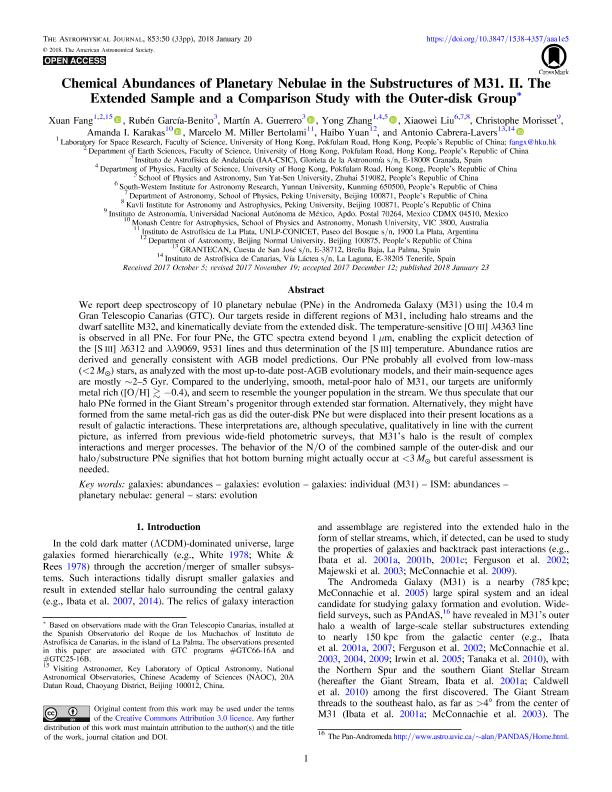Mostrar el registro sencillo del ítem
dc.contributor.author
Fang, Xuan
dc.contributor.author
García-Benito, Rubén
dc.contributor.author
Guerrero, Martín A.
dc.contributor.author
Zhang, Yong
dc.contributor.author
Liu, Xiaowei
dc.contributor.author
Morisset, Christophe
dc.contributor.author
Karakas, Amanda I.
dc.contributor.author
Miller Bertolami, Marcelo Miguel

dc.contributor.author
Yuan, Haibo
dc.contributor.author
Cabrera Lavers, Antonio
dc.date.available
2019-08-30T17:24:55Z
dc.date.issued
2018-01
dc.identifier.citation
Fang, Xuan; García-Benito, Rubén; Guerrero, Martín A.; Zhang, Yong; Liu, Xiaowei; et al.; Chemical abundances of planetary nebulae in the substructures of M31. II. the extended sample and a comparison study with the Outer-disk Group; IOP Publishing; Astrophysical Journal; 853; 1; 1-2018
dc.identifier.issn
0004-637X
dc.identifier.uri
http://hdl.handle.net/11336/82602
dc.description.abstract
We report deep spectroscopy of 10 planetary nebulae (PNe) in the Andromeda Galaxy (M31) using the 10.4 m Gran Telescopio Canarias (GTC). Our targets reside in different regions of M31, including halo streams and the dwarf satellite M32, and kinematically deviate from the extended disk. The temperature-sensitive [O iii] λ4363 line is observed in all PNe. For four PNe, the GTC spectra extend beyond 1 μm, enabling the explicit detection of the [S iii] λ6312 and λλ9069, 9531 lines and thus determination of the [S iii] temperature. Abundance ratios are derived and generally consistent with AGB model predictions. Our PNe probably all evolved from low-mass (<2 M Ȯ) stars, as analyzed with the most up-to-date post-AGB evolutionary models, and their main-sequence ages are mostly ∼2-5 Gyr. Compared to the underlying, smooth, metal-poor halo of M31, our targets are uniformly metal rich ([O/H]-0.4), and seem to resemble the younger population in the stream. We thus speculate that our halo PNe formed in the Giant Stream's progenitor through extended star formation. Alternatively, they might have formed from the same metal-rich gas as did the outer-disk PNe but were displaced into their present locations as a result of galactic interactions. These interpretations are, although speculative, qualitatively in line with the current picture, as inferred from previous wide-field photometric surveys, that M31's halo is the result of complex interactions and merger processes. The behavior of the N/O of the combined sample of the outer-disk and our halo/substructure PNe signifies that hot bottom burning might actually occur at <3 M Ȯ but careful assessment is needed.
dc.format
application/pdf
dc.language.iso
eng
dc.publisher
IOP Publishing

dc.rights
info:eu-repo/semantics/openAccess
dc.rights.uri
https://creativecommons.org/licenses/by-nc-sa/2.5/ar/
dc.subject
Galaxies: Abundances
dc.subject
Galaxies: Evolution
dc.subject
Galaxies: Individual (M31)
dc.subject
Ism: Abundances
dc.subject
Planetary Nebulae: General
dc.subject
Stars: Evolution
dc.subject.classification
Astronomía

dc.subject.classification
Ciencias Físicas

dc.subject.classification
CIENCIAS NATURALES Y EXACTAS

dc.title
Chemical abundances of planetary nebulae in the substructures of M31. II. the extended sample and a comparison study with the Outer-disk Group
dc.type
info:eu-repo/semantics/article
dc.type
info:ar-repo/semantics/artículo
dc.type
info:eu-repo/semantics/publishedVersion
dc.date.updated
2019-08-28T17:58:13Z
dc.journal.volume
853
dc.journal.number
1
dc.journal.pais
Estados Unidos

dc.description.fil
Fil: Fang, Xuan. Chinese Academy of Sciences; República de China
dc.description.fil
Fil: García-Benito, Rubén. Instituto de Astrofísica de Andalucía; España
dc.description.fil
Fil: Guerrero, Martín A.. Instituto de Astrofísica de Andalucía; España
dc.description.fil
Fil: Zhang, Yong. University of Hong Kong; China
dc.description.fil
Fil: Liu, Xiaowei. Peking University; China. Yunnan University; China
dc.description.fil
Fil: Morisset, Christophe. Universidad Nacional Autónoma de México; México
dc.description.fil
Fil: Karakas, Amanda I.. Monash University; Australia
dc.description.fil
Fil: Miller Bertolami, Marcelo Miguel. Instituto de Astrofísica de la Plata (conicet- Universidad Nacional de la Plata); Argentina. Consejo Nacional de Investigaciones Científicas y Técnicas. Centro Científico Tecnológico Conicet - La Plata. Instituto de Astrofísica La Plata. Universidad Nacional de La Plata. Facultad de Ciencias Astronómicas y Geofísicas. Instituto de Astrofísica La Plata; Argentina
dc.description.fil
Fil: Yuan, Haibo. Beijing Normal University; China
dc.description.fil
Fil: Cabrera Lavers, Antonio. Instituto Astrofisico de Canarias; España
dc.journal.title
Astrophysical Journal

dc.relation.alternativeid
info:eu-repo/semantics/altIdentifier/doi/http://dx.doi.org/10.3847/1538-4357/aaa1e5
dc.relation.alternativeid
info:eu-repo/semantics/altIdentifier/url/https://iopscience.iop.org/0004-637X/853/1/50/
Archivos asociados
